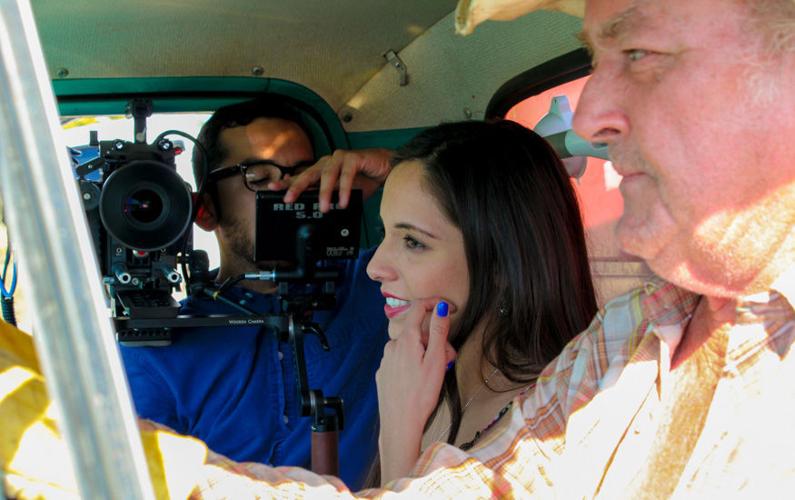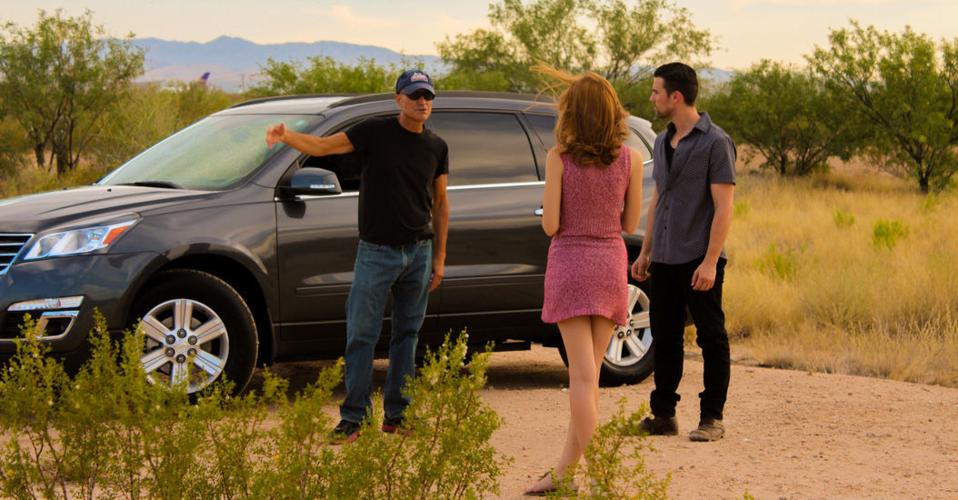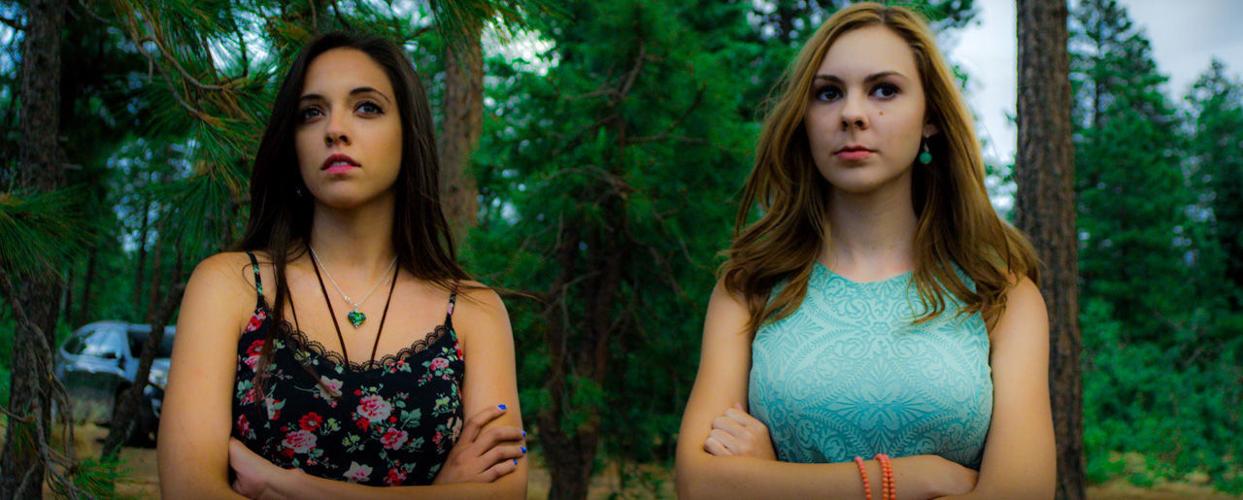This is the story of a movie shot completely in Arizona, with talent from the state’s universities in front of and behind the camera, and a production fully financed by Tucson investors.
No, it’s not science fiction.
The film, “There and Back,” is a love letter to Arizona by writer and director Marcus de Leon, who wanted to create a project that took advantage of all the local talent he had met as a volunteer fellow at the University of Arizona’s Hanson Film Institute.
De Leon, a graduate of UCLA film school, has worked in Hollywood since the early ’90s as a director and screenwriter. Before this movie, his experience in securing financing had been as traditional as the business gets, he said.
“Usually, you got your creative filmmaker on one side and you have your financing sources on the other side, and in between those two are producers and movie studio executives,” he said.
Once de Leon decided to go with an all-Arizona production, he knew there was no way he would be going that route.
“I would have to get 100 percent of the movie financing from Arizona. Because, if I were to go for financing with that cast and crew in Hollywood, I would never get this movie made,” he said.
Starting in 2011, it was two years of hearing “No way” and “Get out of my office,” he said, but in his business you learn to thrive on rejection.
“If you believe in your movie, if you believe in your screenplay, when you hear the word ‘No’ you double down and push even harder,” de Leon said.
The funding would eventually come from the Desert Angels, a Tucson angel investor group. Started in 2000, the Desert Angels have invested almost $40 million in startups, officials said.
Before de Leon came along, none of those startups was a feature film.
“We’d tried a couple of times but never been successful of getting one through our process,” said Curtis Gunn, Desert Angels chairman. “This was the first one that made it through successfully and we’re all very hopeful.”
The process
For de Leon, who was used to the creative side of moviemaking, thinking like a startup took some getting used to. He had to take a crash course in business, he said.
“I feel like I earned my MBA studying how to present to a group like the Desert Angels,” he said. “I had to challenge myself to become an entrepreneurial filmmaker.”
All startups that seek financing from the group must complete an online application process. Every six weeks or so, selected companies present before a screening panel, where representatives come in and do a 10-minute pitch followed by a question and answer session.
If the screening panel likes the pitch, it moves on to a dinner presentation before the entire Desert Angels membership.
Annually, the group receives about 200 applications, officials said. Of those, 60 to 70 make it to the screening panel and only about 17 or 18 present at the dinner meeting. Historically, about half of those companies get funded.
The film pitch was treated like any other startup, Gunn said, or as much as it could be since a movie production is clearly different from a medical device or a prescription drug.
“But at the end of the day we are investors with a profit motive,” he said. “We want to have a return on our investment, and those people that invested in the movie, at least on some level believe they’re doing so to make a financial return.”
The project’s two principal investors, Robert Hungate and Tim Kalthoff, said that along with any profit motive, their interest in the film came with larger goals in mind.
Hungate, who invested in the movie along with his wife, JoAnne, said they wanted to support film development in Arizona, which can be a big economic driver.
“Tucson has a large filmmaking history but it has no coherence in its filmmaking, there’s no strategic thrust,” he said. “We’re trying to see if we can create a little more splash and maybe generate interest.”
Helping people make a start is the whole idea behind angel investing, Kalthoff said, so providing an opportunity for local talent was also a consideration.
“It really is targeted at creating the careers of recent graduates or students from the University of Arizona, Arizona State and NAU,” he said. “That’s very attractive.”
The men, who share executive producer credit on the film, helped de Leon adjust and readjust his pitch as he approached other investors.
“Without them we wouldn’t have this movie,” de Leon said. “And then there was a successive chain of person to person to person in the Tucson area, all of them a link in the chain that got this movie made.”
Although they did not want to reveal the film’s budget, officials said it was within the Desert Angels’ investment range.
“Some of the investment is time, some of it’s money, some of it’s deferment, some of it’s things others have done for us,” Hungate said.
For example, O’Rielly Chevrolet donated two vehicles to the project, de Leon said.
The production also took advantage of Section 181 of the IRS code, which incentivizes film and television production by allowing production costs of up to $15 million to be deducted.
The film was shot over 10 weeks during the summer of 2014, shooting throughout Arizona and putting about 17,000 miles between the nine production vehicles. Unlike some independent productions, everyone who worked on the movie was paid, de Leon said.
“I wanted to establish a professional environment and I wanted people to have the kind of professional commitment to what would be a very rigorous production,” he said.
Post-production
“There and Back” is finishing post-production and de Leon wants to premiere it at a high-profile film festival this year. After that there will be special Arizona premieres in Tucson and Phoenix.
Investors hope the movie will be picked up by a distributor and follow the currently popular model for independent films of releasing a movie in theaters and through video on demand.
The movie’s production was put together through an investment offering, and while the document prepared was specific to “There and Back,” it can work as a template for future projects, de Leon said.
“I have an actual successful movie production to show to Arizona investors. We got it done once, now we’re ready to do it again,” he said.
Although de Leon is already thinking about his next film, the prospect of Tucson investors being involved in other productions hangs on the performance of “There and Back,” said Gunn of the Desert Angels.
“Not to put a lot of pressure on Marcus by any means, but some of the future opportunity will probably depend on the success of this movie,” he said. “If Marcus goes out to the market and it’s not well-received, that could put a pallor on the future mood.”
In the meantime, Hungate and Kalthoff are already being sought out by others to talk about their experience. They said they’ve seen a rough cut of the movie and their optimism remains undiminished.
“Hopefully it creates an avalanche effect and we get more and more involvement in Tucson in these kinds of projects. That would be the end objective for us,” Kalthoff said.






